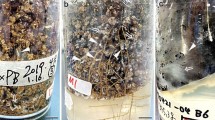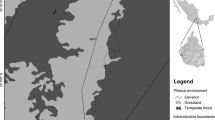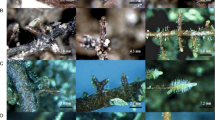Abstract
The growth response of an ornamentalRhododendron hybrid to the inoculation withPhialocephala fortinii was studied in two pot experiments in order to decide about the effectiveness of the inoculation of young rhododendron microplants. Two different substrates were used in both experiments, either sterilized or non-sterilized: a horticultural substrate and a soil collected from a field site with dominant ericoid vegetation. Two fungal isolates were used for an inoculation:P. fortinii strain P (UAMH 8433) andP. fortinii strain F, a dark septate endophyte (DSE) previously isolated from naturally-infected roots ofVaccinium myrtillus. BothPhialocephala strains successfully colonized the roots of the host plants forming typical DSE (=pseudomycorrhizal) colonization pattern including the formation of intracellular microsclerotia. However, pseudomycorrhizal colonization did not affect the growth parameters of the host rhododendrons. The results from both experiments indicate a neutral effect of the inoculation with DSE fungi on the growth ofRhododendron cv. Belle-Heller.
Similar content being viewed by others
References
Bajwa R. &Read D.J. (1986): Utilization of mineral and amino N sources by the ericoid mycorrhizal endophyteHymenoscyphus ericae and by mycorrhizal and non-mycorrhizal seedlings ofVaccinium.Trans. Brit. Mycol. Soc. 87: 269–277.
Barrow J.R. &Aaltonen R.E. (2001): Evaluation of the internal colonization ofAtriplex canescens (Pursh)Nutt. roots by dark septate fungi and influence of host physiological activity.Mycorrhiza 11: 199–205.
Currah R.S., Tsuneda A. &Murakami S. (1993): Morphology and ecology ofPhialocephala fortinii in roots ofRhododendron brachycarpum.Canad. J. Bot. 71: 1639–1644.
Currah R.S. &Tsuneda A. (1993): Vegetative and reproductive morphology ofPhialocephala fortinii (Hyphomycetes, Mycelium radicis atrovirens) in culture.Trans. Mycol. Soc. Japan 34: 345–356.
Fernando A.A. &Currah R.S. (1996): A comparative study of the effects of the root endophytesLeptodontidium orchidicola andPhialocephala fortinii (Fungi Imperfecti) on the growth of some subalpine plants in culture.Canad. J. Bot. 74: 1071–1078.
Hambleton S. &Currah R. S. (1997): Fungal endophytes from the roots of alpine and borealEricaceae.Canad. J. Bot. 75: 1570–1581.
Haselwandter K. &Read D.J. (1980): Fungal associations of roots of dominant and sub-dominant plants in high-alpine vegetation systems with special reference to mycorrhiza.Oecologia 45: 57–62.
Jansa J. &Vosátka M. (2000): In vitro and post vitro inoculation of micropropagated rhododendrons with ericoid mycorrhizal fungi.Appl. Soil Ecol. 15: 125–136.
Jumpponen A. (2001): Dark septate endophytes — are they mycorrhizal?Mycorrhiza 11: 207–211.
Jumpponen A., Mattson K.G. &Trappe J.M. (1998): Mycorrhizal functioning ofPhialocephala fortinii withPinus contorta on glacier forefront soil: interactions with soil nitrogen and organic matter.Mycorrhiza 7: 261–265.
Jumpponen A. &Trappe J.M. (1998a): Dark septate endophytes: a review of facultative biotrophic root — colonizing fungi.New Phytol. 140: 295–310.
Jumpponen A. &Trappe M.J. (1998b): Performance ofPinus contorta inoculated with two strains of root endophytic fungus,Phialocephala fortinii: effects of synthesis system and glucose concentration.Canad. J. Bot. 76: 1205–1213.
Lemoine M.C., Gianinazzi S. &Gianinazzi-Pearson V. (1992): Application of endomycorrhizae to commercial production ofRhododendron microplants.Agronomie 12: 881–885.
Litterick A.M., McQuilken M.P. &Holmes S.J. (1995): Sources ofRhizoctonia species in ericaceous plant nurseries.J. Pl. Dis. Protect. 102: 441–444.
McLean C.B., Cunnington J.H. &Lawrie A.C. (1999): Molecular diversity within and between ericoid endophytes from theEricaceae andEpacridaceae.New Phytol. 144: 351–358.
Monreal M., Berch S. M. &Berbee M. (1999): Molecular diversity of ericoid mycorrhizal fungi.Canad. J. Bot. 77: 1580–1594.
Moore-Parkhurst S. &Englander L. (1982): Mycorrhizal status ofRhododendron spp. in commercial nurseries in Rhode Island.Canad. J. Bot. 60: 2342–2344.
O’Dell T.E., Massicotte H.B. &Trappe J.M. (1993): Root colonization ofLupinus latifolius Agardh. andPinus contorta Dougl. byPhialocephala fortinii Wang & Wilcox.New Phytol. 124: 93–100.
Phillips J.M. &Hayman S.S. (1970): Improved procedures for clearing roots and staining parasitic and vesicular-arbuscular mycorrhizal fungi for rapid assessment of infection.Trans. Brit. Mycol. Soc. 55: 158–160.
Read D.J. &Haselwandter K. (1981): Observations on the mycorrhizal status of some alpine plant communities.New Phytol. 88: 341–352.
Sharples J.M., Chambers S.M., Meharg A.A. &Cairney J.W.G. (2000): Genetic diversity of root-associated fungal endophytes fromCalluna vulgaris at contrasting field sites.New Phytol. 148: 153–162.
Starrett M.C., Blazich F.A., Shafer S.R. &Grand L.F. (2001): In vitro colonization of micropropagatedPieris floribunda by ericoid mycorrhizae. I. Establishment of mycorrhizae on microshoots.Hortscience 36: 353–356.
Stoyke G. &Currah R.S. (1993): Resynthesis in pure culture of a common subalpine fungus-root association usingPhialocephala fortinii andMenziesia ferruginea (Ericaceae).Arctic Alpine Res. 25: 189–193.
Straker C.J. (1996): Ericoid mycorrhiza: ecological and host specificity.Mycorrhiza 6: 215–225.
Vodnik D., Mihelčič M. &Gogala N. (1997): Isolation of root associated fungi fromErica herbacea and their tolerance to lead.Acta Biol. Slovenica 41(4): 35–42.
Vohník M. (2002):Inoculation of Vaccinium vitis-idaeaand Rhododendroncv. Belle-Heller with ericoid mycorrhizal Oidiodendron griseumand pseudomycorrhizal Phialocephala fortinii. MSc. Thesis. Department of Plant Physiology, Faculty of Science, Charles University, Prague.
Wang C.J.K. &Wilcox H.E. (1985): New species of ectendomycorrhizal and pseudomycorrhizal fungi:Phialophora finlandia, Chloridium paucisporum andPhialocephala fortinii.Mycologia 77: 951–958.
Wilcox H.E. &Wang C.J.K. (1987): Mycorrhizal and pathological associations of dematiaceous fungi in roots of 7-month-old tree seedlings.Canad. J. Forest Res. 17: 884–899.
Author information
Authors and Affiliations
Corresponding author
Rights and permissions
About this article
Cite this article
Vohník, M., Lukančič, S., Bahor, E. et al. Inoculation ofRhododendron cv. Belle-Heller with two strains ofPhialocephala fortinii in two different substrates. Folia Geobot 38, 191–200 (2003). https://doi.org/10.1007/BF02803151
Issue Date:
DOI: https://doi.org/10.1007/BF02803151




